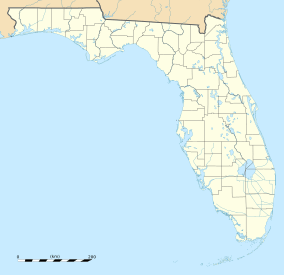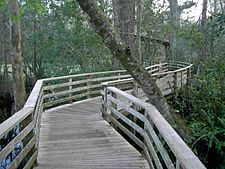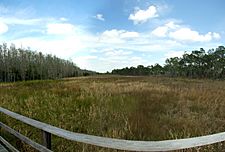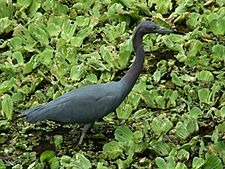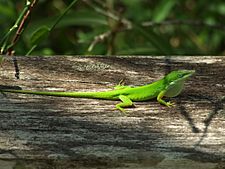Corkscrew Swamp Sanctuary facts for kids
Quick facts for kids Corkscrew Swamp Sanctuary |
|
|---|---|
|
IUCN Category V (Protected Landscape/Seascape)
|
|
| Location | 375 Sanctuary Rd W, Naples, FL 34120 Collier County, Florida, United States |
| Nearest city | Naples, Florida |
| Governing body | National Audubon Society |
| Designated: | 23 March 2009 |
| Reference #: | 1888 |
| Designated: | March 1964 |
Corkscrew Swamp Sanctuary is a special nature reserve in southwest Florida, near Naples, Florida. It is managed by the National Audubon Society, an organization that works to protect birds and their homes. This sanctuary was created to save some of the biggest remaining groups of bald cypress and pond cypress trees in North America. These trees were being cut down a lot in the 1940s and 1950s, so the sanctuary helps keep them safe.
Contents
A Look Back at Corkscrew Swamp
In 1954, a group called the Corkscrew Cypress Rookery Association was formed. Their goal was to protect this important natural area. The National Audubon Society then took over managing the sanctuary. In 1955, they started building the first boardwalk through the swamp.
Over time, nearly 45 square kilometers (17 square miles) of wetland were bought or given to the sanctuary. Much of this land came from its original owners, Lee Tidewater Cypress Center Co. and Collier Enterprises.
Water Levels at the Sanctuary
In 2018, scientists at the Sanctuary noticed something important. They found that the amount of groundwater in the park started to decrease around the year 2000. They have been keeping records of water levels since 1957.
Their studies showed that other changes in the area, like new roads or draining land for buildings, had not affected the water levels before. But since 2000 or 2001, the water now drains away quickly during the dry season. Before, it used to dry up slowly. The amount of rain during the wet season has stayed the same. Scientists are still trying to find out why this is happening and what it means for the sanctuary and Collier County.
Exploring the Sanctuary
A boardwalk, just over 3 kilometers (1.9 miles) long, lets visitors walk through different parts of the sanctuary. You can see pine flatwoods, wet prairies, and areas with pond cypress and bald cypress trees. There are also marsh areas.
In 2017, Hurricane Irma knocked down some bald cypress trees. This damaged parts of the boardwalk. Most of the damage was fixed, but a few small sections are now closed permanently.
Amazing Wildlife
The sanctuary is a key spot on the Great Florida Birding Trail. It is a very important place for the endangered wood stork to raise its young. Many other wetland birds also live here. You might see the yellow-crowned night heron, black-crowned night heron, and tricolored heron. Large birds like the great egret and snowy egret are also common.
Special birds like the limpkin and barred owl live here year-round. In the summer, you might even spot a swallow-tailed kite. During winter, many small birds, including the colorful painted bunting, come to the sanctuary. Besides birds, you can also find American alligators and cottonmouth snakes in the swamp.
The sanctuary's visitor center also has a special system called a Living Machine. This system uses plants and microbes to naturally clean water, showing how nature can help us.
Images for kids
-
Male little blue heron
-
Male Anolis carolinensis


